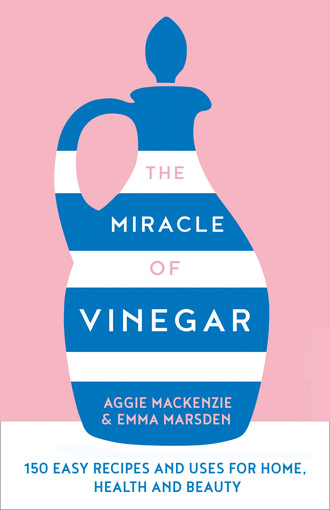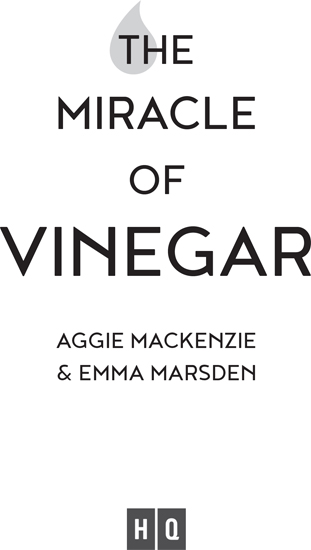
Полная версия
The Miracle of Vinegar


Copyright

An imprint of HarperCollins Publishers Ltd
1 London Bridge Street
London SE1 9GF
First published in Great Britain by HQ in 2019
Copyright © Aggie MacKenzie and Emma Marsden 2019
Aggie MacKenzie and Emma Marsden asserts the moral right to be identified as the author of this work.
A catalogue record for this book is available from the British Library.
This novel is entirely a work of fiction. The names, characters and incidents portrayed in it are the work of the author’s imagination. Any resemblance to actual persons, living or dead, events or localities is entirely coincidental.
All rights reserved under International and Pan-American Copyright Conventions. By payment of the required fees, you have been granted the non-exclusive, non-transferable right to access and read the text of this e-book on-screen. No part of this text may be reproduced, transmitted, downloaded, decompiled, reverse engineered, or stored in or introduced into any information storage and retrieval system, in any form or by any means, whether electronic or mechanical, now known or hereinafter invented, without the express written permission of HarperCollins.
Ebook Edition © December 2018 ISBN: 9780008310585
To my gorgeous sons Rory and Ewan for their enduring patience, boundless creativity and sharing their brilliant recipe ideas with me.
— Aggie
Thanks to my mum for my culinary drive, to Kev for always tasting everything I’ve made (no matter what time of day) and to the rest of my family for their support.
— Emma
CONTENTS
Cover
Title Page
Copyright
Dedication
INTRODUCTION
THE HISTORY OF VINEGAR
TYPES OF VINEGAR
Which Vinegar When?
CLEANING TIPS
Kitchen
Bathroom
Laundry
Living Room
Other Ingenious Uses
HEALTH AND BEAUTY TIPS
Silky Skin Solutions
Treatments for Healthy-looking Hair
Pamper Feet and Hands
Tips and Tricks for Make-up Accessories
Soothing Cold Treatments
Ease Aches and Pains
Nasty Infections
Healthy From Inside Out
Give Your Body a Boost
And That’s Not All…
RECIPES
QUICK AND LIGHT MEALS
Use Vinegar to Poach Eggs
Rich Pickings From the Vegetable Drawer
Spiced Chickpeas for Fish, Chicken, Salad, Yogurt or Hummus
Hot Smoky Chicken for a Bun
One-pan Peanut Butter Noodles
Make the Most of Wizened Veg
MAINS
Friday Night Steak and Sides Two Ways
Special Slow-roasted Tomatoes
Braised Lamb With Rosemary and Red Wine
Five-hour Pulled Pork
Pork Vindaloo
Cheat’s Chicken Tikka
Duck With Walnuts
Three Ways With Raspberry Vinegar
Red Pepper, Chickpea and Harissa Dressing for Pan-fried Hake
Mullet Escabeche
Stuffed Courgettes Asian-style
SALADS
3 Classic (Ish) Salads and Their Dressings
A Simple Couscous Salad
Red Wine Vinegar Adds Zing to an Italian Salad
Making the Most of Preserved Tuna
DIPS AND SAUCES
Quick Dill Sauce for Smoked Fish
Homemade Hoisin-style Sauce
A Softer-tasting Aioli for Pan-fried Fish
One-minute Dips for Chips
A Canny Tip to Stretch an Avocado to Feed a Few More
Dipping Sauce for Spring Rolls and Dumplings
Classic Dressing for Oysters
SNACKS AND NIBBLES
Drinks Nibbles
Hot Salt and Vinegar Crisps
Cumin-spiced Nuts
Chilli-spiced Olives
The Beauty of Balsamic
Mushroom Toast Topper
Sherry Vinegar Mushrooms
DESSERTS
Sweet Raspberry Vinegar for Ice Cream and Drinks
Bring Out the Sweetness in Strawberries
Peaches With Verjus and Rosemary
Chocolate Sharing Mousse With Blueberries and Pecans
Golden Pavlova
BREAD AND BAKING
Chilli and Thyme Cornbread
Courgette and Carrot Loaf
Seeded Soda Bread
PICKLES AND PRESERVES
Red, White and Green Piccalilli
Pickled Pears With Star Anise and Ginger
Spiced Plums With Cinnamon, Juniper and Black Pepper
Super-quick Bowl of Chutney
About the Publisher
INTRODUCTION

Vinegar first came into my working life while I was at Good Housekeeping magazine in the early 1990s. I was director of the Institute and in this role I oversaw both the consumer testing and cookery departments. Each year, the January issue of the magazine carried a ‘Stains Special’… and vinegar always featured prominently.
When, in 2002, I was asked to do a screen test for a new television programme about cleaning, I drew on my GH experience and rattled off a list of all the kooky remedies I had picked up over the years, and again vinegar enjoyed multiple name-checks.
I passed the screen test, got the TV gig and co-presented How Clean is Your House? on Channel 4 from 2003 to 2009. My co-presenter and I generally used old-fashioned, inexpensive and homespun remedies for clean-ups – and very soon vinegar became the star of the show.
I am currently, about once a month, the ‘Midnight Expert’ guest on the BBC Radio 5 Live Phil Williams show. People call in and text between midnight and 1am with their cleaning quandaries – it’s strange but true, there is never any shortage of queries, even at that late hour. So often have I named vinegar as the solution to removing a stain that Phil, a good while back, instigated ‘Aggie’s Vinegar Bingo’, in which a big shout-out goes to the caller who, during the on-air hour, nails the nearest time to the V-word first getting a mention. Who knew vinegar could create so much buzz?
Vinegar is said to have been discovered by accident around 10,000 years ago, and it can be made from almost any fermentable item – such as wine, apples, pears, grapes, berries, beer and potatoes.
For over 2000 years, vinegar has been used to flavour and preserve foods, heal wounds and fight infections – as well as clean surfaces. There is some evidence that vinegar added to one’s diet will reduce the glucose response to a carbohydrate load both in healthy adults and in sufferers of diabetes. It has also been suggested that drinking a little vinegar each day is useful as a dietary aid because it imparts a feeling of fullness. Since I began working on this book I have been drinking two tablespoons of organic cider vinegar with a tiny squeeze of honey every morning. Who knows whether it’s doing me any good, but I am sure it won’t be doing me much harm either.
Both my sons are chefs in leading London restaurants and often use specialist vinegars for finishing dishes. Through them I have learned what a difference it can make and how to use it judiciously in my cooking.
It seemed natural that I should put my head together with that of my friend and former cookery editor colleague at Good Housekeeping, Emma Marsden, to come up with a book that combines my cleaning-with-vinegar expertise and her extensive culinary knowledge. Here is our – we hope – useful collection of tips, plus recipes that are, without exception, exciting, innovative and, importantly, straightforward. We hope you’ll enjoy them, together with beauty remedies and health hints – all using this humble yet important liquid in its many and various forms.
Aggie MacKenzie

THE HISTORY OF VINEGAR
The word vinegar comes from the French vin aigre, translated as sour wine, which accurately describes it. If you’ve ever left the dregs of an open bottle of wine for a few days and then attempted to drink the contents, only to be met with a sour taste, you’ve already started on the journey of vinegar-making. There are records of this magic ingredient being made as early as 5,000 BC in Babylon, and it’s thought that it was the result of a slipup while fermenting some wine. People cooking at that time experimented with this liquor, discovering that it could be used as both a condiment and ingredient.
Today it is a popular ingredient, produced commercially by either fast or slow fermentation. In fast fermentation, the liquid is oxygenated and the bacteria culture added. Slow fermentation is generally used for the production of specialised vinegars used in cooking; the culture of acetic acid bacteria grows on the surface of the liquid and fermentation evolves gradually over weeks or months and allows for the formation of a harmless slime made up of yeast and acetic acid bacteria, also known as the vinegar mother.
As history has already told, you can by all means leave a bottle of wine open – covered with a cloth that lets in air but not fruit flies – and eventually it will turn into vinegar. It may take months, though, so if you want to speed up the process and guarantee a result, here are a few pointers.
Firstly, vinegar is like sourdough and yogurt, in that it’s good to have some kind of starter to begin with. With sourdough it’s a leaven to add to flour and water; with yogurt it’s a couple of tablespoons of yogurt to add to milk that’s then heated. For vinegar, it’s some unpasteurised vinegar with the mother to start the process. These bottles are labelled clearly and you can buy them online and in supermarkets and delis.
Secondly, you need time. The mixture of wine and a vinegar mother won’t turn into vinegar overnight. You need a dark cupboard and the patience to wait for the mixture to ferment and the bacteria from the vinegar mother to turn the alcohol into acetic acid.
Thirdly, you need oxygen from the air, so use a wide-mouthed jar or ceramic pot and cover it with muslin or cheesecloth so the oxygen can get in but bugs can’t.
Whether you’re making wine or beer vinegar (see here), the basic recipe is much the same. Pour 400ml red wine or beer into a large open-mouthed jar (either ceramic or glass) then pour 200ml unpasteurised cider vinegar with the mother into the jar, too. Cover with a muslin or cheesecloth square and secure with a band. Label and store in a cool dark place for at least one month. It may take longer depending on conditions, but just keep tasting as you go. Some vinegar will naturally evaporate so, depending on how long it takes for the vinegar to brew, you’ll get around 400ml to use. You may find that a jelly-like substance forms in the liquid – don’t bin this, lift it out and transfer to another sterilised jar and use it to make another batch of vinegar with some of the unpasteurised liquor you’ve just fermented.

TYPES OF VINEGAR
With such an array of vinegars available, it can be bewildering to know which to choose – you don’t want to use an expensive sherry vinegar to clean your windows, nor might you want to add a brash distilled malt to a casserole.
The most common vinegars produced in this country are malt (the brown stuff you put on fish and chips) and distilled malt (the clear type used in cleaning and food preserving).
With wine and sherry vinegars, the quality of the base alcohol used has a direct bearing on how good the vinegar will taste. A decent wine vinegar will be aged for a number of years in wooden casks, which imbues complex and mellow tones.
Balsamic is in a class of its own: look for the terms tradizionale and DOC. Cheap versions will have been coloured and flavoured with caramel and won’t have the authentic flavour balance.
The inclusion of a good wine or sherry vinegar in a soup or stew can often reduce the amount of salt you would normally use. It can also help you cut the amount of fat required in a recipe because vinegar is a great balancer of flavours, thus lessening the need for as much cream, butter or oil. It’s worth experimenting with different types – you’ll soon find out what best suits you. As you read through the descriptions of the most popular vinegars here, we’re sure you’ll identify one or two that will match your palate and style of cooking.
WHICH VINEGAR WHEN?
BALSAMIC VINEGAR
The more you pay, the better the quality. Look for a vinegar that has been aged for several years and contains more grape must than wine vinegar – it will have a syrupy consistency and a fabulous depth of flavour. Save your posh one to use with figs and strawberries.
• • •
BEER VINEGAR
No surprises here – the base of this is beer, but it is brewed with a vinegar mother to achieve the acidity. Flavours vary from lighter styles to dark rich notes depending on which ale is used.
• • •
CHINESE VINEGAR
The main ingredients here are the same as rice vinegar, sometimes with added spice, and the colour comes from an additive. Good for marinades and stir-fries.
CIDER VINEGAR
Also known as apple cider vinegar. Similar to a sharp, acidic flat cider with a vinegary, apple-y aftertaste. Next time you’re cooking pork chops, add a knob of butter to the pan juices plus a splash of this for a simple sauce. Or try this in a quick tuna pâté (see here). It also has some digestive benefits (see here).
• • •
DISTILLED MALT VINEGAR
This is produced by the distillation of malt, which gives a clear, colourless vinegar. Inexpensive; used mainly in pickling and preserving, and also for cleaning.
• • •
HONEY VINEGAR
Sharp and bright with no hint of sweetness. It has a strong kick, so use it sparingly. Good with the Chocolate Sharing Mousse here.
• • •
MALT VINEGAR
Made from barley and dark brown in colour. It has a very sharp taste; it is traditionally sprinkled over fish and chips, but it’s also really useful when making big batches of pickles or chutneys as it’s inexpensive.
• • •
MOSCATEL VINEGAR
Sweet and raisin-y, with hints of honey and florals. If this is used in a dressing, reduce the suggested sugar quantity so as not to overdo the sweetness. Good with a soft, creamy blue cheese such as Gorgonzola dolce or Beauvale. For a new twist, use in the classic dressing for oysters – sauce mignonette (see here).
• • •
RASPBERRY VINEGAR
Bright pink with a thick consistency and a predominant fruity taste with a tart edge. Keep it for salad dressings and try it in the recipes here.
• • •
RED WINE VINEGAR
It’s really worth pushing the boat out with this type of vinegar and looking for a particular grape, such as Merlot or Cabernet Sauvignon, as the flavour of these is incomparable. Some specialist red wine vinegars have been mixed with grape juice, which softens the sharpness, and are good for splashing into a dish of dark fruits. Or use them for finishing off a game dish. A basic red wine vinegar is fine for everyday dressings, but when you want a subtle sharpness with complex flavours, you do need to shell out for something a little more special. A good-quality red wine vinegar will have a well-rounded flavour that’s tangy rather than acidic, and will also be less likely to cause acid reflux or heartburn in those prone to it.
• • •
RICE VINEGAR
This is made from rice and water, which are left to brew and then sometimes flavoured with salt. Useful for quick pickles (eg radish and cucumber) or for splashing over stir-fries.
• • •
SHERRY VINEGAR
Like sherry itself, from Fino to PX there’s a huge range of flavours for this vinegar – and again, the more you spend, the more complex the character. Some makes have colour added, so check the bottle before you buy. A basic one is good added to gravies, or use it to cut through a fatty sausage – see tip here or the couscous salad here. The PX vinegar is sweetish and smooth and works well with dark fruits such as blackberries.
• • •
VERJUS
Not strictly a vinegar, but it is often used in the same way to finish off recipes or added to pan sauces. It’s made by pressing unripened green grapes and has a raisin-y/apple-y aroma and taste. Also good with summer fruits – see Peaches with Verjus and Rosemary here – and salads that feature toasted nuts and cheeses. It’s not as sharp as most vinegars, so it allows other ingredients to sing rather than be swamped.
• • •
WHITE WINE VINEGAR
The go-to for a light salad dressing when you need a touch of acidity – use one-part vinegar to three-parts mild olive oil. You can also use it to make a shallot pickle to go with a curry as here.

CLEANING TIPS
A large Norwegian study widely publicised in the UK at large Norwegian study widely publicised in the UK at the beginning of 2018 showed that regular use of cleaning sprays has a negative impact on lung health – similar to smoking 20 cigarettes a day over 10 to 20 years.
Vinegar, on the other hand, is biodegradable and provides a hostile environment for many types of germs. What makes it such a good cleaning agent? Acidity. Shop-bought distilled malt vinegar (the clear stuff) contains around 5% acetic acid and 95% water – fine for most general cleaning.
Vinegar is great for cutting through soap scum and limescale on shower glass, grease on cooker tops, and it’ll strip wax build-up from a wooden floor. There’s almost no end to the multitude of types of dreck it can conquer. (But don’t use it on marble because it will mark the soft stone.)
You might want to vary the dilution depending on the task: you could use neat vinegar for mould on grouting or to disinfect a chopping board, whereas a 50:50 solution with water will work for general wiping down. A quick spritz of this mix will neutralise kitchen and bathroom smells.
Because it’s natural, it’s great for outdoor jobs such as wiping down patio furniture, cleaning exterior windows… and even getting rid of weeds!
KITCHEN
LIMESCALE ON TAPS
No need to spend your hard-earned cash on specialist products – much better to use bog-standard distilled malt vinegar (the clear, colourless stuff) instead. For ordinary chrome taps (don’t use this on special finishes, it might be too strong and ruin your bespoke surface), soak a few sheets of kitchen paper with the vinegar, wrap these around the taps and cover with a plastic bag. Secure the lot with an elastic band so that the vinegar stays in contact with the taps and does its work. Leave on overnight, then the next morning, the scale should lift off fairly easily – just wipe it with a cloth. If it’s really thick and annoyingly stubborn, repeat the process. You can take off any remaining bits of scale with a plastic scourer.
• • •
DESCALE YOUR KETTLE
If you live in a hard-water area you’ll definitely have limescale, and the build-up of this is one of the main reasons why electric kettles meet their death. When the metal element gets coated with scale, this stops the heat getting into the water as efficiently, which can cause overheating (which will shorten the kettle’s life). Stop this happening by descaling the kettle about once a month: fill it with half water and half clear vinegar – make sure it comes up over the scale line – and bring it to the boil. Switch off and leave overnight. Please note – it is really important to use clear vinegar for this; if you use the brown malt variety, the liquid inside the kettle will massively expand and erupt and you’ll have a vinegary water mess all over the floor (this happened to me). Empty the kettle, rinse, refill and reboil a couple more times with plain water until every last trace of vinegariness has gone. If the scale is really bad and it’s not all gone, repeat the process. If there are bits of scale around the rim, where the vinegar doesn’t quite reach, gently rub around here with an emery board and it’ll come off easily.
Next time you buy a kettle, get one with a built-in water filter. It’ll improve the taste of your tea, get rid of scum and help reduce the amount of limescale build-up. Other things you can do are empty and rinse before refilling with fresh water each time you boil (this helps to get rid of loose scale), boil only as much water as you need, pour away any surplus water before it cools down, and empty the kettle before you go to bed.
• • •
ANYONE FOR SCALE-FREE COFFEE?
If your electric coffee maker has become a bit grotty and scalebound, add a 50:50 ratio of clear vinegar and tap water to the water chamber and run the machine through a cycle, sans coffee. Repeat this a couple more times, just with plain water. Some coffee-machine makers want you to use their own descalers, so check the instructions first to see if that’s the case (it could affect the warranty if anything went wrong).
• • •
DEODORISE YOUR DISHWASHER
If your machine has suddenly developed a nasty whiff, first remove and wash the filter in hot soapy water, then check the spray arms for any bits of food and clean them, too. If you’ve never done this (which is perhaps the reason why you may have one or two problems), check the machine’s manual to find out how to do it – it’s really easy, and it’s a good idea to do this weekly. Also, take a wodge of kitchen paper along the gap where the bottom of the door meets the base of the machine – you might get a shock at the amount of rotting dreck lurking there. Once you’ve done those bits, throw a cup of clear vinegar into the machine and run an empty cycle – this is great for keeping the pipes clear of grease and limescale.
• • •
BRING A SHINE TO YOUR FLOOR TILES
A soap-based cleaner can leave a tiled floor cloudy and dull, so to get that shiny finish, use a solution of mainly warm water with a good slug of clear vinegar. Make sure your mophead is made of microfibre (it cleans way more effectively, and most can be washed in the machine. There is no point in ‘cleaning’ a floor with a filthy mop).
• • •
BLOCKED SINK?
Before you call out an emergency plumber or spend a small fortune on environmentally unfriendly products, try this. Mix together 200g coarse salt and 100g bicarbonate of soda and pour it down the drain. Follow this with a cup of any type of vinegar plus a kettle full of boiling water. You’ll witness a mini-explosion in your sink, but this is good – it’ll help clear the blockage. Often (if the pipes are blocked with some solidified fat, for instance) this’ll do the trick.




